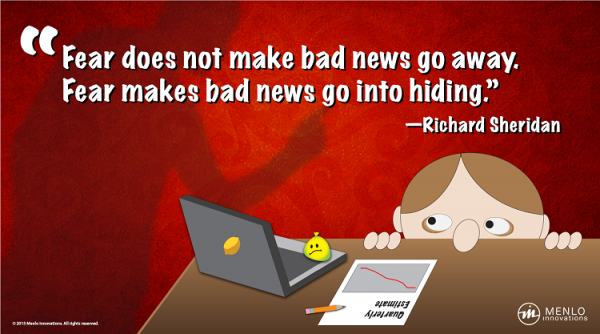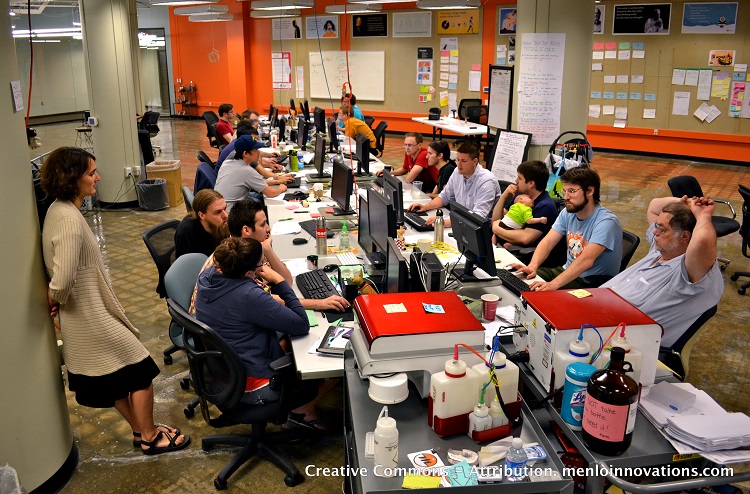Joy, Inc. – Business Value of Joy
Interview with Rich Sheridan, Author of Joy, Inc. – How We Built a Workplace People Love and CEO of Menlo Innovations in Ann Arbor, Michigan. Over 3,000 annual visitors flock to Ann Arbor to tour Menlo and be inspired by the unique Menlo way. Among them are Lean experts and companies like Toyota.
This conversation is part of an Interview series on Lean Transformation & Lean Culture, created by Noventa Consulting. The conversation with Rich is split into four parts.
Part 1: Joy, Inc. – Learning Organization
Part 2: Joy, Inc. – Business Value of Joy
Part 3: Joy, Inc. – Leadership Lessons and Inspirations
Part 4: Joy, Inc. – Cultural Transformation
Could you elaborate on the business value of joy?
I was moved by Simon Sinek’s TEDx talk, in which he stated that most organizations talk about what they do and how they do it, but only a few companies explain why they do it. Simon Sinek encourages leaders to start with why. Someone who heard me speak sent it to me and said, “Rich, you do this. You did this so well.” Moreover, I listened to the talk, and I thought, okay, I get it. You feel my passion you feel my energy, so you think I do that, but I seldom start with why. I always talk about Menlo as software design development firm with a unique way of working. I might eventually get to the why, but I never started with why.
At Menlo, people come and visit us from all over the world to do a company tour. I decided that day to start the tour with our why and thought, what am I going to say? I was a little bit caught I wasn’t and didn’t know what to say. Finally, it dawned on me looking at our mission statement; we’ve been talking about joy since our beginning. We’ve told that we’re going to put the joy back into this unique endeavor inventing software. The joy is why we exist, and we believe, that it is our passion.
So, this group came in the door, and I said, “Welcome to Menlo. You’ve come to a place that has very intentionally created a culture focused on the business value of joy.” So it just stopped them dead in their tracks. They came to Menlo to learn about how you build software and why you do it the way you do it. Why are you talking about joy?
I pointed back to this room full of people here, and I said, “Let’s pretend you had a software project you wanted us to build for you, and let’s pretend further that half of my team had joy and the other half didn’t. Tell me which half would you want to work on your software project?”
Also, of course, they immediately said, “Well, we want the joyful half, of course.” I asked “Why? What difference would it make? Why would you care?” They answered said, “Well, they’d care more about the outcome, produce better quality, are more productive, would be easier to work with, and the efforts would be more enjoyable to use.” I looked at them and said, “Okay, so you’re telling me that there is tangible business value to joy?”
I said “I’m going to take you for a tour now that you know our why. I’m going to start showing you how we do what we do and you can stop me anywhere. Stop me at any artifacts, stop me at any process I describe, stop at anything you see and say, ‘Rich, what does that thing right there what does that have to do with producing joy?’” I said, “I will be able to draw a short, straight line back to our purpose back to why we exist. I will be able to draw a short line back to joy.” That day has changed my life.
Karen Martin heard me tell the story once at a conference in Phoenix, Arizona and she was relentless with me. She called me shortly after the conference and said, “Rich, you have to write a book about what you just told us.” I said, “Well, I’ve been thinking about writing a book.” She goes, “Oh, no. You’re done with thinking. You are going to write this book.” I said, “Well, I don’t know the process.” She told me, “I do. I’ve written several books. I will tell you what to do.” Sure enough, the book now exists. I often say that Karen Martin is the reason Joy, Inc. exists as a book because she was not going to let me escape planet earth without having written that book.
How does Menlo Innovations hire for culture fit?
It’s a great question. We knew right from the beginning that we had such a unique culture and way of collaborating, for which the conventional recruiting process wouldn’t work. I jokingly refer to a standard interview, as two people lying to each other for a couple of hours.
A programmer pair at Menlo will work together for forty hours this week. Each of them has to express certain qualities every single minute of every day to have a productive relationship. Hiring for this paired environment needs a different approach, so we reinvented the interview process. We designed our interviews as an audition. We’ll bring in thirty to fifty people at a time, at 4:00 pm. We are pairing one candidate with another, and then we give them the strangest instruction. The goal of each candidate is to make sure that their pair partner gets a second interview. If the partner is struggling, help him out. Each candidate works in three different pairs for twenty minutes each.
One of my team members is going to observe you and what they’re looking for are good kindergarten skills, do you play well with others, do you share, do you support the person sitting next to you, do you make your partner look good? We switch pairs in the audition so that we see the candidates work with different personality types. In two hours we have auditioned thirty to fifty people.
Afterwards, the candidates go home, and we stay here and grab dinner. The fifteen observers are talking about what they saw. Three people would have seen each person. If they all give an enthusiastic thumbs-up, we don’t even talk about you, you automatically get into the second round, and we move on to the next person. In case not all the observers are in favor, we will discuss the person in detail.
Lean thinking makes this process incredibly quick. The audition takes place between 4:00 pm and 6:00 pm
So, imagine this, you know, and I know in Lean thinking this is amazing. We bought thirty people at 4:00 in the afternoon, by 6:00 you’re all going home. By 9:00, between 6:00 and 9:00 we have reviewed thirty people, made a decision, and by the next morning we’re starting to send out e-mails to those who made it and those who didn’t. Our interview process is speedy.
It’s beautiful. Now, Collin whom we talked about made it through. Then, we invite him for a one-day trial. That’s what he’s doing today.
In the one-day trial, he will pair with Helen in the morning and switch pairs in the afternoon. We’re considering three more votes. We’re looking for the approval of the two people he worked with, as well as his vote, now that he got a chance to see what it feels like to work here. He might say, yeah, this is amazing, but I could never work here. That’s okay.
We’re not trying to be all things to all people. We’re not going to change ourselves to bring Collin in the mix. He could read the book, he could come to listen to Rich talk, or he could watch YouTube videos about an enthusiastic, passionate CEO. However, there’s no substitute for what does it feel like to work here. During the one-day-trial, we see whether he has the right technical skills or not and if he culturally fits.
How do you teach cultural values to the team?
I think through storytelling predominantly. On my business card, it says Chief Storyteller. History is storytelling. We propel civilization, nations, and community forward with stories. We retell the stories that are most important to us, the ones that evoke our deepest cultural beliefs and they can be negative stories. They can be stories about bad things that happened, that’s okay. It doesn’t have only to be positive stories.
However, in telling those negative stories there’s a lesson learned, there’s an ethic there’s some moral, it’s like Aesop’s Fables, right? So, by telling the stories of Menlo and quite frankly some of the stories of Rich and James’ life before Menlo and why we created it the first place. The team begins to understand the passion of its visionary leaders and then, of course, they also learned the art of storytelling, and we have a team full of storytellers. It’s not only the chief storyteller anymore; there’s a whole bunch of storytellers.
Could you elaborate on pumping fear out of the room?
A sign on our wall says that fear does not make bad news go away, fear makes bad news go into hiding. If I pump fear into the room, the information will start to look perfect. If I pump enough fear into the room, every project will be on time, and every project status is green. There are no problems to solve; the world is perfect. Until, of course, one day it isn’t, and then there’s a crisis, there’s a disaster, we’ll all be walking around going, how could this happen? Yesterday, everything was perfect, and now all of a sudden, we’re in chaos because some pipe broke. Was there any indication of a leaking pipe before? There are no leaking pipes around here. I don’t know what happened, boss.
It’s incredible; we think that we motivate with fear, but we’re doing the opposite.

You talked about the energy crisis that companies are facing; 70% of the workforce have a low engagement with their job.
These statistics are as old as I am. No matter how many books are written or how many classes are taught on this subject, the number is constant. We are in an energy crisis. If you think of all the people walking in your door every day, whom you’re paying and how many of them have quit. They leave their brain out in the car or on the pillow at home, and you’re getting them in name only.
The energy crisis, I see as one of the most significant opportunities that exist for leaders today. Imagine if we flip the equation around. The people with a low engagement already work for us. [part two of four – Interview will be continued]
Links
- The famous TED Talk by Simon Sinek, watched over 5 million times: https://youtu.be/u4ZoJKF_VuA
- Simon Sinek: https://startwithwhy.com/
- Menlo Innovations: https://www.menloinnovations.com/
- Menlo factory tour: http://menloinnovations.com/by-visiting/menlo-factory-tour
- Joy, Inc. factory tour: http://menloinnovations.com/by-visiting/joy-inc-factory-tour


